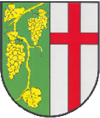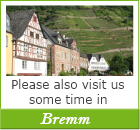The early wine villages
Within the district of Ediger-Eller, the oldest traces of settlement date back to the younger Stone Age. This can be proven by different finds.
The settlements of Ediger and Eller were built at the exits of three side valleys leading to the stream as so-called "Fährgassendörfer":
From a road running along the higher part of the village, so-called "ferry lanes" lead down to the riverbank, where today's Moselle Wine Road, which was built in 1853, runs.
The streams supplied the villages with the necessary fresh water. The old fountains are still running and today form popular meeting places.
The name Ediger, originally "ethegreia", comes from the Celtic and means sandy shore. The name refers to the location of the place, which is built on the sands washed out of the streams of the side valleys, the alluvial areas.
According to an imperial declaration of 1363, Ediger remained a village on the one hand, but received town rights and an elaborate fortification, which is still very well preserved today.
However, it remained an important village with corresponding influence and wealth, as evidenced by the many half-timbered houses from the 16th, 17th and 18th centuries.
Eller, the Erlendorf, is also of Celtic origin. It was probably named after the adjacent and alder-lined Ellerbachtal.
While the Counts of Pyrmont exercised the High Court, Eller flourished immensely under the Electors of Trier and became of supra-regional importance. More than 70 villages delivered their tithes in the Ellerer Zehnthaus, there was even their own Ellerer measure. During this time, courts of the nobility were built all over the village.
In 1879 came the railway and with it a station in Eller. The station was an important transshipment point for wine and the Lohe from the surrounding forests. The Kaiser Wilhelm Tunnel with its impressive portal was considered the longest tunnel in Germany for 108 years.
The excellent wines from the surroundings of the Calmont and from the steep slopes of Ediger and Eller were widely known and attracted monasteries and nobility, excellent vineyards were named after you. A large number of stately half-timbered houses as well as spiritual and aristocratic wine farms still determine the townscape of Ediger-Eller today.
Art-historical treasures bear witness to this important past.
Since 1969, the formerly independent villages have been combined into a double municipality.
This article is already 47487 Once seen.







